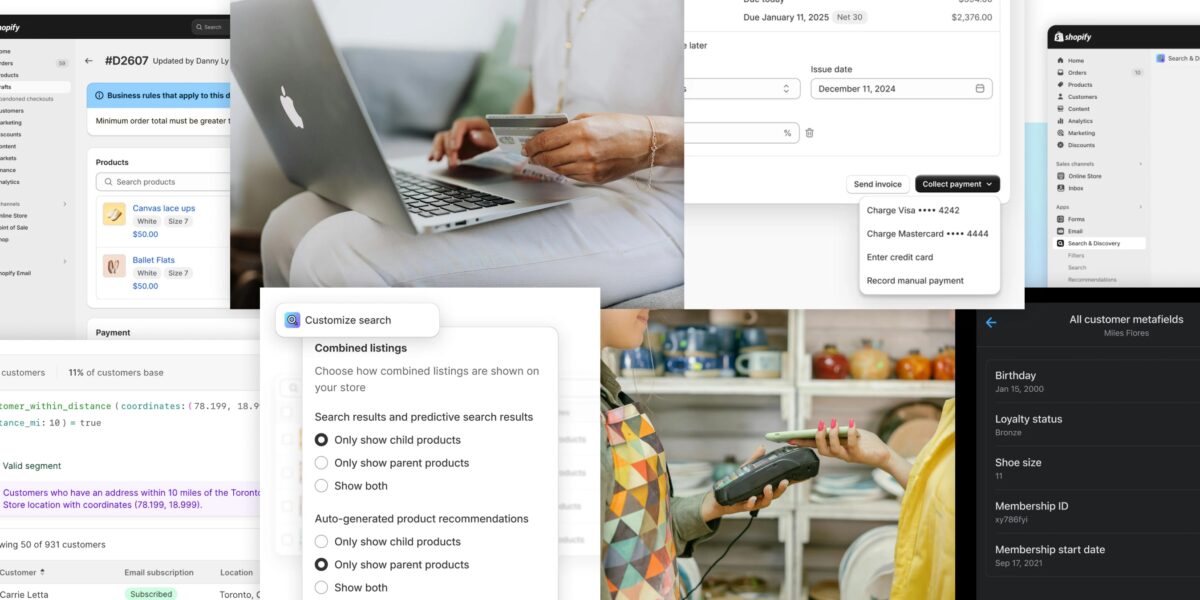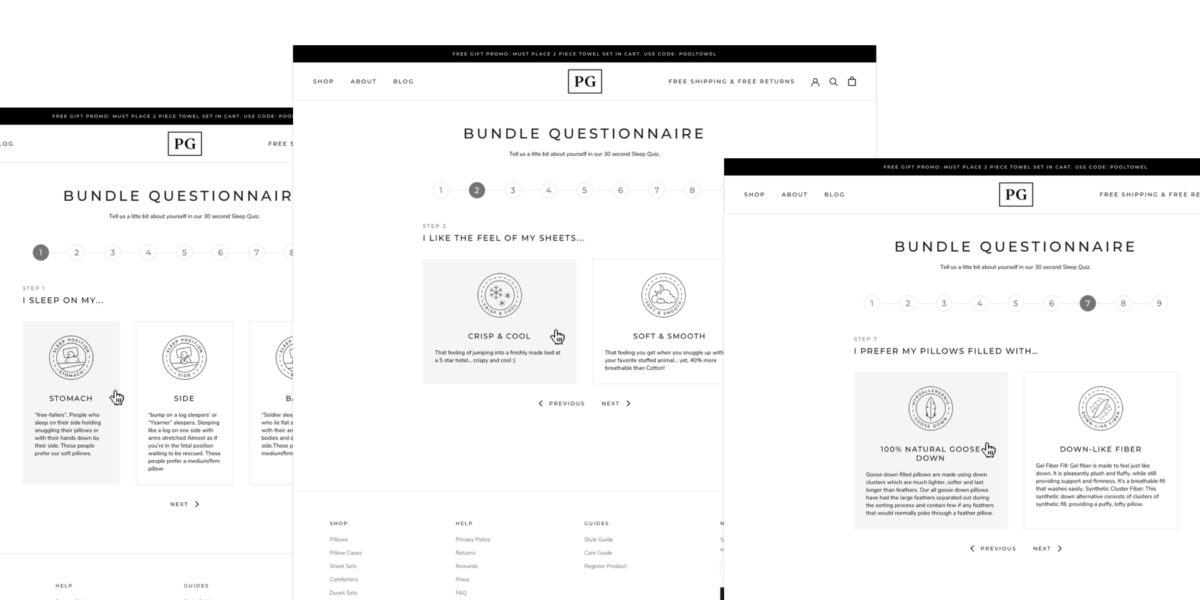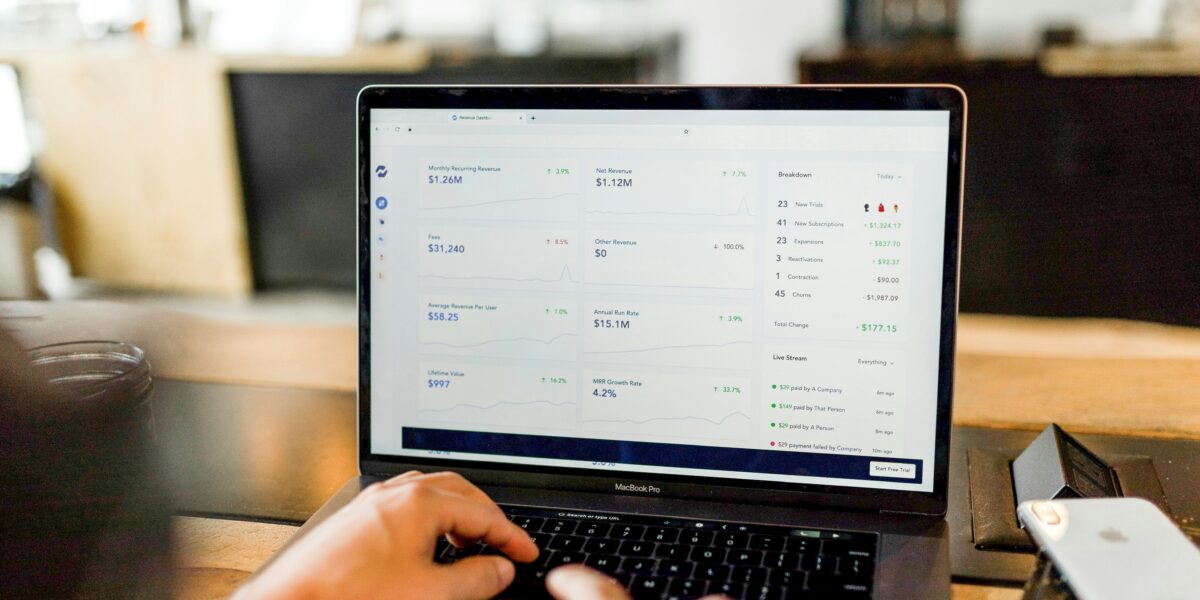Finding Your Sweet Spot
Throughout the years of building Shopify websites for clients, it’s become apparent that it’d be really helpful to break down the differences between each of Shopify’s plans and pricing structures. If you haven’t noticed, we think Shopify is awesome and our clients love it, but a recurring question that comes up quite often goes something like this: “Which plan is right for us and which one should we pick?” Totally fair question. We’re going to lay out the basic differences of Shopify’s plans, “Basic,” “Shopify,” and “Advanced,” which you can basically think of as Small, Medium, and Large. No, not Venti, Grande, Tall, let’s just keep it simple, stupid.
The fact of the matter is that choosing which plan is best for your business depends on how much you sell in a month, how you choose to process your payments, and which Shopify features you need. Choosing any old plan might slow you down on the one hand, or totally overshoot your needs on the other. What it comes down to is the Goldilocks theory—this one’s too small, this one’s too big, but this one’s just right. In this post, we’ll go over the fundamentals of cost and features of the Shopify Pricing plans. It’s worth noting here that Shopify offers more options than just these three plans. Shopify Plus, for example, goes above and beyond as far as E-Commerce solutions. It’s the super-sized version. The Big Gulp, the 4×4 burger at In-N-Out, the… well, you get the idea, right? We’ll touch on that here briefly, but we’re going to focus mainly on the 3 core plans offered with standard Shopify.
So let’s start here. What are the Shopify plans?
First, there’s “Basic Shopify”, available for only $29/month not included any additional fees or charges (which we’ll explain in greater detail below). This plan is aptly named for what it offers: The basics. This plan is great if you’re just looking to get your feet wet when it comes to selling online. Not to say that your business itself is “basic”—we would NEVER assume that, unless your drinking Pumpkin Spice Lattes, then such an assumption is really fair game. Now we have a gross taste in our mouths, but what we’re getting at is that basics are great at first for individuals or small businesses just starting up, but it’s usually not a long-term solution. Oh yeah, it only allows for up to two “staff accounts” so if you have more than a couple people administering the site, this just won’t do.
The “medium” plan is a step up from Basic, and is the most popular plan. Shopify refers to this plan as just straight “Shopify” at this point, which leads us to believe its the standard plan. We’re going to refer to it as “middle,” because it’s right in the middle of the pricing grid. This plan is available for $75/month plus fees. The middle plan is thought to be best for growing businesses as it allows up to five staff accounts along with some other key benefits.
Shopify’s Advanced plan, available for $299/month plus additional fees, is best for established businesses with a higher volume of sales, more robust shipping options, and more. The Advanced plan comes with a wider range of features than Basic or Middle would, many of which are also available on the Shopify Plus plan. One of the most notable differences is that Advanced allows for 15 staff accounts and real-time shipping rates through UPS and FedEx.
Shopify Plus is the soup-to-nuts plan for businesses with high-volume or enterprise-level sales, starting at $2000/month. It sounds like quite a jump, and it is, but this is nothing when you compare it to other similar solutions or… opening up an actual brick and mortar location where your rent is most likely quite a bit more. What this rate offers is usually sufficient for most Plus stores (unless you’re Kylie Jenner selling cosmetics and, literally, breaking the internet. We haven’t broken the internet yet, but we’re trying. We’ll let you know as soon as we pull it off). Don’t you worry, we’ll better explain the extra costs breifly below.
Shopify Payments – Shopify’s own payment gateway
The Basic, Middle and Advanced plans assume and encourage you to use Shopify Payments for your gateway. All websites need a payment gateway to connect your checkout to your underlying merchant account. A merchant account is an account that accepts payments electronically but doesn’t hold a balance. The money passes from your online store to your bank. In other words, this is how you get paid! Cha-ching!!! That’s really what it’s all about, right?!
By the way, Shopify Payments, Stripe, and Paypal bundle this up into one service in similar ways. This means a higher cost for you, but that’s because they make signing up easy and instant, taking on the risk upfront without getting to know each business. So Shopify Payments is Shopify’s payment gateway, which is provided with each plan and offers some pretty cool benefits. For example, customers can enter payment information at checkout without leaving the online store. Also, you can set up Shopify Payments directly from your Shopify admin, and even view your payouts in real-time. Regardless of which plan or payment gateway you choose, you’re going to have to pay a processing fee (the amount of which depends on which plan you choose) for accepting major credit cards like Visa or MasterCard. It’s just that simple, there’s no getting around it. These rates are ultimately dependent on the underlying rates set by credit card companies themselves, so don’t shoot the messenger here! The credit card rates for each plan are as follows:
Basic: 2.9% and 30¢ per transaction
Middle: 2.6% and 30¢ per transaction
Advanced: 2.4% and 30¢ per transaction
Plus: TBD (Enquire to find out)
Established businesses might find better rates by provisioning their own merchant account, but this means you’ll need a third party gateway to connect to your account. Another huge benefit of using Shopify Payments for your credit card processing, is that you can also have Amazon Pay and Paypal and they don’t add any additional transaction fees on top. If you use another credit card payment gateway, they do.
Using & choosing a third party gateway
Shopify offers a lot of flexibility in the payments arena, which gives you the opportunity to choose the one you’d like to use. But, using a third party gateway instead of Shopify Payments will mean Shopify charging you a commission fee, a.k.a “transaction fee,” (not to be confused with the credit card rate per transaction outlined above). We’ll refer to it as “commission” because let’s be honest, that’s pretty much what it is.
Once you reach a high volume of sales, it might be more affordable to use your own merchant account rather than Shopify Payments, and consider a plan that charges a low commission or transaction fee. You can find Shopify’s breakdown of the major payment gateways for the US, UK, Canada, and Australia here as well as the international and additional payment gateways.
The commission rates for each plan are as follows:
Basic: 2%
Middle: 1%
Advanced: 0.5%
Plus: 0%
Shopify Plus does not charge a commission, and this is why upgrading is desirable to most clients that are doing a substantial amount of volume because a transaction fee or a few percentage points can add up quickly in those cases. Sure, the cost starts at $2000/month, which might initially seem pretty steep, but you may at some point be spending that much in fees and commission anyway. Say you’re turning over $400,000/month in revenue and paying a 0.5% commission rate through the Advanced plan when not on Shopify Payments. This equates to $2,000 each month for commission alone. In this case, upgrading is really a no-brainer. Even if you’re not at that volume of sales just yet, it’s still a good idea to consider an upgrade to Plus simply because of the features and benefits that Basic, Middle, and Advanced just don’t offer.
Speaking of features and benefits… what are they?
We’ve already covered the costs and fees associated with each plan, but let’s dive into what really sets them apart from one another. Shopify has tried to implement certain features across the board, like the number of products you can have in your store, or available file storage, (both of which are unlimited, by the way). Other across-the-board features include the ability to print shipping labels, 24/7 customer support (from Shopify to you, the business owner), fraud analysis, manual order creation, discount codes, website and blog options, a free SSL certificate, and some variation of a Shopify shipping discount. In addition, all plans can upgrade their Shopify Retail package for a flat rate of $49.
The basic plan, which we agreed is best for new or small businesses, does not include gift cards, professional reports, or abandoned cart recovery. The Middle plan, as a step up from Basic, does include these features, but neither Basic nor Middle comes with an advanced report builder, nor do they calculate third-party shipping rates. The Advanced plan includes all of these features. Check out Shopify’s fancy table for a visual breakdown of the costs and features of each plan. It’s also worth mentioning that you aren’t locked into any plan, you can upgrade or downgrade any time, quickly and easily from the admin panel.
Ok, so which plan should you use?
Here’s a punch list for each to break it down and help recap:
The Basic Plan:
- Individuals or small businesses that want a low monthly rate
- Low order volumes and/or minimal revenue coming through the store
- Don’t mind a few percentage points on the credit card processing
- Aren’t worried about saving some costs on shipping rates
- Can get away with flat rate, table rate or USPS shipping. (No UPS or FedEx)
- Don’t need gift cards, professional reports, abandoned cart recovery, the ability to make advanced reports.
- Need two or less staff admin accounts
The Middle “Shopify” Plan:
- Small to mid-sized businesses that do a solid amount of transactions regularly, and place more value on their site.
- You’d like the ability to offer Gift cards
- You’d like to get slightly lower percentage rates and transaction fees
- You’d benefit from professional reports that will allow you to get a better look at how your site’s doing and how you might improve it.
- You want the ability to recover abandoned carts. (Which is by the way highly recommended as it can help to capture a lot of sales that might have otherwise been lost.
The Advanced Plan:
- You are a small to big business that does a lot of business through their store and would like the most robust standard Shopify plan and associated features.
- You’d like to get the lowest percentage rates and/or transaction fees available on the standard Shopify plans.
- You’d like a way to build advanced reports
- You would like to offer real-time shipping rates through UPS and FedEx. This last one’s a big one—this makes shipping much more accurate and when shipping’s not as accurate, it means two things. Either you are paying more for shipping than you are charging, or your customer is paying extra for shipping. Either way, it’s usually a lose lose.
Shopify Plus:
Plus is another animal entirely and is most definitely entitled to an article to cover it alone. we’ll be hashing out the Shopify Plus package in a separate article soon. We know the edge of your seat is going to get a bit worn out, but it will be worth the wait.
Have more questions about which plan is right for you? Hit us up and we’d be happy to do a nice little pow wow about it.
















